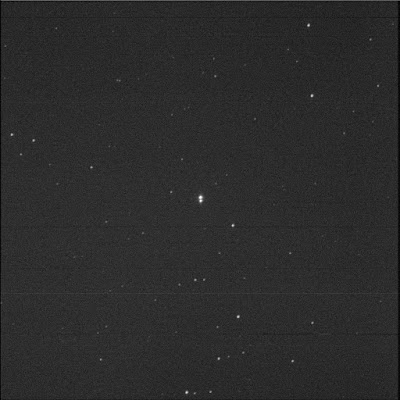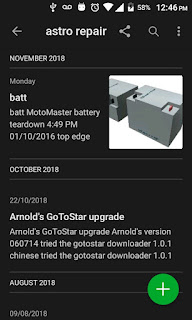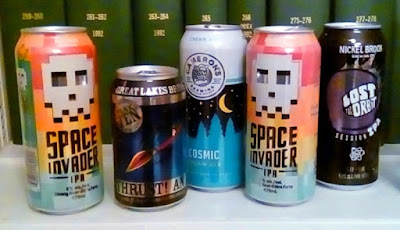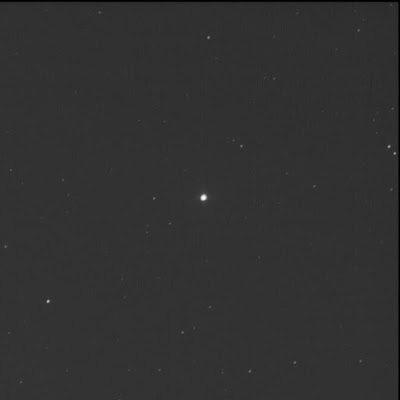The NASA InSight probe successfully landed on Mars.
Now waiting for solar panel deploy and a first camera image.
§
An amazing part of this mission was the use of cube sats flying in tandem to relay data.
§
The first image was received at 15:00 EST. Up is up and left is left! ;-)
Monday, November 26, 2018
Friday, November 23, 2018
tried for U Cam
I had also loaded a request for BGO to capture U Cam, a very red star. Sadly, the job didn't complete, due to stoopid clouds, so I'll have another go later.
§
Collected all colour data on 7 Dec.
§
Collected all colour data on 7 Dec.
Labels:
double stars,
photography,
variable stars,
weather
aimed at HD 20588 (Halifax)
Fantastic! I had selected this Camelopardalis target from Sissy Haas's book partly for the interesting colour descriptions... "Gloss white, peach white, bluish khaki." OK. She shows the labels OΣ 373 (for AB) and OΣΣ 33 (for AC). For fun I requested HD 20588 and BGO captured the data.
North is up; east is left. Luminance only, 1 second sub, a stack of a dozen shots. FITS Liberator, Paint.NET.
Now SkyTools 3 Professional refers to these stars as STF 373 and STTA 33. Who is right?
Clearly a quadruple system. Haas only notes 3 stars.
A is the brightest element in the centre of the image.
B is the tight companion to the east-south-east. The dimmest of all in the group.
C is the bright star further along, past B.
D is to the south of the partnership, less than A and C in luminance but brighter than B. ST3P shows this star is designated STU 1.
Looking forward to working this in colour...
There are other neat groupings of stars in the field.
§
Checked the Washington Double Star catalogue and found:
North is up; east is left. Luminance only, 1 second sub, a stack of a dozen shots. FITS Liberator, Paint.NET.
Now SkyTools 3 Professional refers to these stars as STF 373 and STTA 33. Who is right?
Clearly a quadruple system. Haas only notes 3 stars.
A is the brightest element in the centre of the image.
B is the tight companion to the east-south-east. The dimmest of all in the group.
C is the bright star further along, past B.
D is to the south of the partnership, less than A and C in luminance but brighter than B. ST3P shows this star is designated STU 1.
Looking forward to working this in colour...
There are other neat groupings of stars in the field.
§
Checked the Washington Double Star catalogue and found:
03221+6244STF 373AB
03221+6244STTA 33AC
03221+6244STU 1AD
Labels:
Apogee,
books,
double stars,
photography
imaged Struve 219 (Halifax)
Full Moon. So I asked for a double star. HD 13247 aka STF 219 in Tri. For fun. The BGO returned this:
Luminance only, 1 second subexposure, 12 in the stack. FITS Liberator, Paint.NET. North is up; east is left.
The B companion is slightly dimmer and nearly due south. Interesting field stars...
My SkyTools software shows three tight stars on the chart but that must be an error. I don't see anything between the bright pair. At the same time the planning app says HD 13247 is a double with a mag 8 and 9 star separated by 11 seconds of arc. The software allow shows a colourful star to the south-west. It will be interesting to work this in colour...
Oh, the pair was on my DS candidate list... I'll have to check it visually.
There's a faint pair of equal stars, even tighter, to the north-east. No designation. Neat.
The zig zag of stars to the south, to the edge of the image frame, is intriguing. There are two sets of three stars aligned...
Luminance only, 1 second subexposure, 12 in the stack. FITS Liberator, Paint.NET. North is up; east is left.
The B companion is slightly dimmer and nearly due south. Interesting field stars...
My SkyTools software shows three tight stars on the chart but that must be an error. I don't see anything between the bright pair. At the same time the planning app says HD 13247 is a double with a mag 8 and 9 star separated by 11 seconds of arc. The software allow shows a colourful star to the south-west. It will be interesting to work this in colour...
Oh, the pair was on my DS candidate list... I'll have to check it visually.
There's a faint pair of equal stars, even tighter, to the north-east. No designation. Neat.
The zig zag of stars to the south, to the edge of the image frame, is intriguing. There are two sets of three stars aligned...
Labels:
Apogee,
double stars,
photography
Wednesday, November 21, 2018
darkness
Dark mode arrived to Evernote! Woo hoo! Well, for iOS and Android. Still waiting for Windows and the web. A lot of us (including Robert Sawyer) have been asking for this, for years.
This will improve on dark adaptation when I need to check my notes while at the telescope.
Once they deploy this for the other platforms, I can finally transition from using Windows Notepad for live logging...
This will improve on dark adaptation when I need to check my notes while at the telescope.
Once they deploy this for the other platforms, I can finally transition from using Windows Notepad for live logging...
Labels:
dark adaptation,
logging,
software
your monthly double stars
Issued my double star "bulletin" for November. It is a short list of suggested double and multi-star targets. I shared this on the RASC Toronto Centre forums. And I post here for all.
§
I don't know why I bother, really. I mean, we're not going to see stars at night until May 2019, right?!
Anyhoo, if you're lucky to get the odd clear night between now and then, pop into the back garden or onto the deck and have a look. Double stars are visible from anywhere, even in the city, and any time, even with a bright Moon.
Here are some suggestions:
Happy hunting. Let me know how you did!
Blake Nancarrow
astronomy at computer-ease dot com
§
Frank shared his observations on the RASC forum on 29 Dec '18.
He also pointed out a mistake in the Mesarthim or Σ180 entry. It should be γ (gamma) not lambda.
While investigating I found I had quoted the SAO number for λ. gamma's alternate catalogue number should be SAO 92681.
§
I don't know why I bother, really. I mean, we're not going to see stars at night until May 2019, right?!
Anyhoo, if you're lucky to get the odd clear night between now and then, pop into the back garden or onto the deck and have a look. Double stars are visible from anywhere, even in the city, and any time, even with a bright Moon.
Here are some suggestions:
| star | also known as | alternate catalogue |
|---|---|---|
| 59 And | Σ222 | SAO 55330 |
| 32 Eri | (Struve) Σ470 | SAO 130806 |
| Mesarthim or Σ180 | SAO | |
| 66 Cet | (STF) Σ231 | SAO 129752 |
| 77 Psc | Σ90 | SAO 109666 |
Happy hunting. Let me know how you did!
Blake Nancarrow
astronomy at computer-ease dot com
§
Frank shared his observations on the RASC forum on 29 Dec '18.
He also pointed out a mistake in the Mesarthim or Σ180 entry. It should be γ (gamma) not lambda.
While investigating I found I had quoted the SAO number for λ. gamma's alternate catalogue number should be SAO 92681.
Labels:
double stars,
error,
fun,
light pollution,
Moon,
planning,
RASC
Wednesday, November 14, 2018
Binary Universe: checking sidereal time
The December 2018 edition of the RASC Journal celebrates our 150 years looking back to its early days and origins to current activities today. I look forward to reading every piece within.
Whoa! A greeting from the only governor general who has flown in space, Her Excellency the Right Honourable Julie Payette! Very cool!
The article by Mr Rosenfeld on art inspired by astronomical things looks fascinating.
Mr MacDonald has returned to masks in photographic image manipulation. I still struggle with this.
In my Binary Universe column, I discuss time, specifically determining sidereal time (as I need to do now when calibrating the DDO's 74-inch mount). I talk about Stellarium, SkySafari, Polar Finder, MySiderealTime, SkyTime, Astro Clock Widget, and Emerald.
Whoa! A greeting from the only governor general who has flown in space, Her Excellency the Right Honourable Julie Payette! Very cool!
The article by Mr Rosenfeld on art inspired by astronomical things looks fascinating.
Mr MacDonald has returned to masks in photographic image manipulation. I still struggle with this.
In my Binary Universe column, I discuss time, specifically determining sidereal time (as I need to do now when calibrating the DDO's 74-inch mount). I talk about Stellarium, SkySafari, Polar Finder, MySiderealTime, SkyTime, Astro Clock Widget, and Emerald.
found the December Journal
Wait a second. If Jeff was thanking me for referring him to the Astro Clock Widget, then that meant he had read the RASC Journal December edition! Oh. It's been released. I hadn't seen a notice anywhere... I surfed into the national web site, logged in, and spotted the latest. OK.
Labels:
RASC
Jeff thanked me re. ACW
Jeff pinged me via email. Thanked me for the tip on the Astro Clock Widget. No worries.
Labels:
Android,
friends and family,
RASC,
software
Tuesday, November 13, 2018
a moon, a planet, a star (Bradford)
Spotted the young Moon as I walked from the train station.
Quite far to the left I tagged a tiny but intense orange point. Ah. Mars.
I briefly considered setting up. But it was late. I hadn't had dinner. My stomach was growling. It wasn't perfectly clear...
And then, while northbound on Toronto Street, shimmering Capella.
Bad seeing.
Quite far to the left I tagged a tiny but intense orange point. Ah. Mars.
I briefly considered setting up. But it was late. I hadn't had dinner. My stomach was growling. It wasn't perfectly clear...
And then, while northbound on Toronto Street, shimmering Capella.
Bad seeing.
rockets!
There was a bowl at reception filled with candy from Hallowe'en. "Rockets!" I exclaimed. I was encouraged to take some. I stuffed my pockets!
Did you know that Rockets were made by Eddie Dee? The Ce De Candy Company Limited, now known as Rockets Candy Company, started making Rockets on Queen Street, Toronto in 1963.
Did you know that Rockets were made by Eddie Dee? The Ce De Candy Company Limited, now known as Rockets Candy Company, started making Rockets on Queen Street, Toronto in 1963.
Labels:
fun
Monday, November 12, 2018
received OH 2019
Woo hoo! Found the RASC Observer's Handbook 2019 in the mailbox!
Rhonda asked what was on the cover. The Flying Bat and the Squid apparently.
Rhonda asked what was on the cover. The Flying Bat and the Squid apparently.
imaged Palomar 1 (Halifax)
I continue to try to "see" the Palomar globular clusters. This is Palomar 1 in Cepheus.
Centering on the star GSC 04517 01909, I commanded the Burke-Gaffney Observatory to gather some photons. Can you see it?
Luminance frame, 10 seconds, 10 subexposures. Apogee camera.
The globular is the small, faint, gathering of dim stars slightly below and right of centre.
These objects are extremely challenging. So I don't know what I was thinking exactly with respect to the exposure settings. 10 seconds?! Will try again with a much longer exposure time.
Centering on the star GSC 04517 01909, I commanded the Burke-Gaffney Observatory to gather some photons. Can you see it?
Luminance frame, 10 seconds, 10 subexposures. Apogee camera.
The globular is the small, faint, gathering of dim stars slightly below and right of centre.
These objects are extremely challenging. So I don't know what I was thinking exactly with respect to the exposure settings. 10 seconds?! Will try again with a much longer exposure time.
Labels:
Apogee,
globular clusters,
photography
Sunday, November 11, 2018
more operator training
We did more training on the 74-inch telescope. There were about a dozen in the session. We spent some time working on our presentation, conveying science information and some history of the David Dunlap Observatory facility. Chilly in the dome!
Saturday, November 10, 2018
helped at musical astronomical evening
Helped at the RASC Toronto Centre special event Beyond the Skies held at the David Dunlap Observatory.
This was an unique evening with jazz music by The Calderons, regular alcoholic beverages along with themed cocktails, and some astronomy. Amazingly, we had clear skies. I wore a few hats. I helped with audio-visual setup and teardown for the band and the speakers Ian W and Bhairavi. With my new Smart Serve certification, I assisted Reanu at the bar. And I helped with general tasks too.
I was surprised to get asked to debug an issue for Denise and Chris with the 74-inch telescope. Busy night, long, but lots of fun.
Peter V shot photos and loaded them up to a Facebook album.
We offered a couple of science-themed beers. In addition to Space Invader and Cosmic and Corona, we had a couple I hadn't heard of: Thrust! An IPA and Lost In Orbit. Thrust! is by Great Lakes Brewery while Lost in Orbit, an IPA session beer, is by Nickel Brook Brewing.
This was an unique evening with jazz music by The Calderons, regular alcoholic beverages along with themed cocktails, and some astronomy. Amazingly, we had clear skies. I wore a few hats. I helped with audio-visual setup and teardown for the band and the speakers Ian W and Bhairavi. With my new Smart Serve certification, I assisted Reanu at the bar. And I helped with general tasks too.
I was surprised to get asked to debug an issue for Denise and Chris with the 74-inch telescope. Busy night, long, but lots of fun.
Peter V shot photos and loaded them up to a Facebook album.
We offered a couple of science-themed beers. In addition to Space Invader and Cosmic and Corona, we had a couple I hadn't heard of: Thrust! An IPA and Lost In Orbit. Thrust! is by Great Lakes Brewery while Lost in Orbit, an IPA session beer, is by Nickel Brook Brewing.
Monday, November 05, 2018
shot Spirograph in narrowband (Halifax)
Along with the LRGB information, I retrieved narrowband data on the Spirograph planetary in the constellation Lepus.
Hydrogen-alpha, 60 seconds subexposures, 10 stacked shots.
Ionised oxygen, 60 seconds subexposures, 10 stacked shots.
For both, FITS Liberator and Paint.NET. North is up; east is left.
Hydrogen-alpha, 60 seconds subexposures, 10 stacked shots.
Ionised oxygen, 60 seconds subexposures, 10 stacked shots.
For both, FITS Liberator and Paint.NET. North is up; east is left.
Labels:
photography,
planetary nebulae,
SBIG
shot Spirograph in colour (Halifax)
Sort of. I wanted to image the Spirograph Nebula, IC 418, again. I overexposed the small planetary nebula in my first attempt in January 2017. So, shot 4 times faster this time.
Luminance only, 15 seconds subexposures, 10 stacked shots. FITS Liberator, Paint.NET. North is up; east is left.
I also wanted to get narrowband data.
Won't see this in full colour of course until I do some work in a photo editor...
Luminance only, 15 seconds subexposures, 10 stacked shots. FITS Liberator, Paint.NET. North is up; east is left.
I also wanted to get narrowband data.
Won't see this in full colour of course until I do some work in a photo editor...
Labels:
photography,
planetary nebulae,
SBIG
Sunday, November 04, 2018
tried NGC 281 again (Halifax)
Shot the Pac-Man Nebula (NGC 281) again, aimed at TYC 36630 06351. I was hoping to avoid gradient and satellites in the colour data...
Luminance frame at 30 seconds and 10 subexposures. FITS Liberator and Paint.NET. North is up and left is right.
Finally got some good LUM data! No nasty gradient at the bottom. No airplanes. No satellites. No tumblers. Pretty good registration. I'll take it.
I had last worked on this object in August 2016.
Luminance frame at 30 seconds and 10 subexposures. FITS Liberator and Paint.NET. North is up and left is right.
Finally got some good LUM data! No nasty gradient at the bottom. No airplanes. No satellites. No tumblers. Pretty good registration. I'll take it.
I had last worked on this object in August 2016.
Labels:
Apogee,
emission nebulae,
NGC,
photography
captured tangled galaxies (Halifax)
For fun, I asked the Burke-Gaffney Observatory to image the two entangled galaxies in Arp 278.
Luminance frame at 60 seconds, 10 subexposures, FITS Liberator, Paint.NET. North is up and east is left.
These are interacting galaxies NGC 7253A and NGC 7253B.
§
I tried to visually observe this pair on 24 Sep '17.
Luminance frame at 60 seconds, 10 subexposures, FITS Liberator, Paint.NET. North is up and east is left.
These are interacting galaxies NGC 7253A and NGC 7253B.
§
I tried to visually observe this pair on 24 Sep '17.
Labels:
Apogee,
Arp,
galaxies,
NGC,
photography
real not real
As the crew departed the International Space Station in early October, they did a fly-around, something not done since the shuttle missions. They acquired some amazing imagery. But one really struck me, reminding me of one of the iconic images from 2001: A Space Odyssey.
Fiction:
Non-fiction:
Now, admittedly, it's not an apples to apples comparison on a number of levels.
It's the imagery that impressed me, the composition, the similarities in the framing.
Copyrights and credits by the respective parties.
See the whole set at SpaceflightNow.
§
NASA made their own comparison a few years back...
Fiction:
Non-fiction:
Now, admittedly, it's not an apples to apples comparison on a number of levels.
It's the imagery that impressed me, the composition, the similarities in the framing.
Copyrights and credits by the respective parties.
See the whole set at SpaceflightNow.
§
NASA made their own comparison a few years back...
Thursday, November 01, 2018
fuzzy Moon (Bradford)
Spotted a fuzzy old crescent Moon in the sky while walking to the train station. Surprisingly high up. Couldn't see anything else. No bright points of light could punch through the cloud.
§
Stellarium said it was about 56° in altitude.
§
Stellarium said it was about 56° in altitude.
Subscribe to:
Posts (Atom)


















